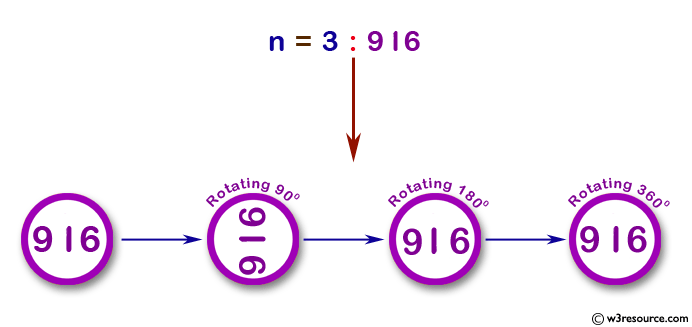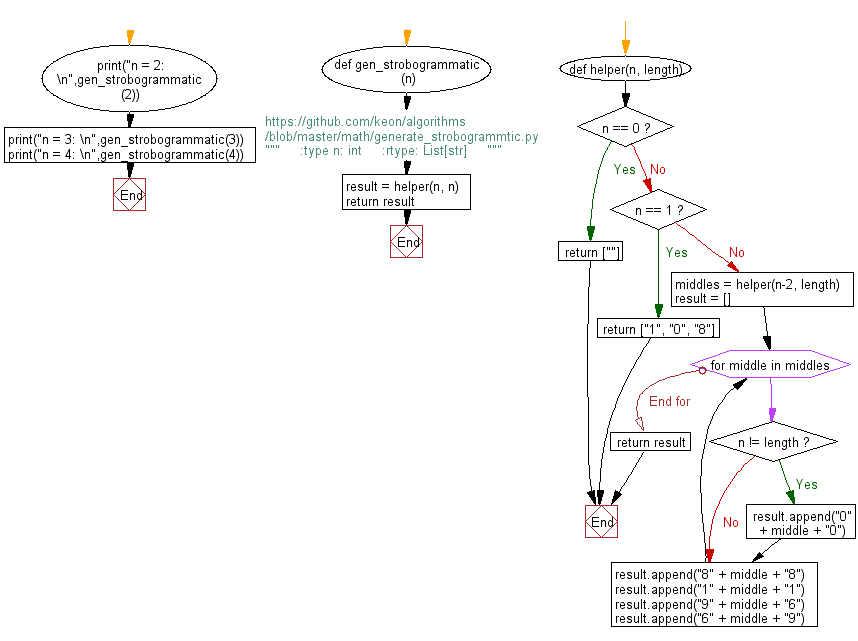Python: Get all strobogrammatic numbers that are of length n
Strobogrammatic Numbers
Write a Python program to get all strobogrammatic numbers that are of length n.
A strobogrammatic number is a number whose numeral is rotationally symmetric, so that it appears the same when rotated 180 degrees. In other words, the numeral looks the same right-side up and upside down (e.g., 69, 96, 1001).
For example,
Given n = 2, return ["11", "69", "88", "96"].
Given n = 3, return ['818', '111', '916', '619', '808', '101', '906', '609', '888', '181', '986', '689']
Visual Presentation:

Sample Solution:
Python Code:
# Define a function 'gen_strobogrammatic' that generates strobogrammatic numbers of length 'n'.
def gen_strobogrammatic(n):
"""
:type n: int
:rtype: List[str]
"""
# Call the helper function with the given length 'n'.
result = helper(n, n)
return result
# Define a helper function 'helper' to recursively generate strobogrammatic numbers.
def helper(n, length):
# Base case: when 'n' is 0, return an empty string.
if n == 0:
return [""]
# Base case: when 'n' is 1, return the strobogrammatic digits for length 1.
if n == 1:
return ["1", "0", "8"]
# Recursive case: generate strobogrammatic numbers for 'n-2'.
middles = helper(n-2, length)
result = []
# Iterate over the generated middles and create strobogrammatic numbers.
for middle in middles:
# If 'n' is not equal to the original length, add "0" on both sides.
if n != length:
result.append("0" + middle + "0")
# Add strobogrammatic numbers with "8" in the middle.
result.append("8" + middle + "8")
# Add strobogrammatic numbers with "1" in the middle.
result.append("1" + middle + "1")
# Add strobogrammatic numbers with "9" in the first half and "6" in the second half.
result.append("9" + middle + "6")
# Add strobogrammatic numbers with "6" in the first half and "9" in the second half.
result.append("6" + middle + "9")
return result
# Test the function with different values of 'n' and print the results.
print("n = 2: \n", gen_strobogrammatic(2))
print("n = 3: \n", gen_strobogrammatic(3))
print("n = 4: \n", gen_strobogrammatic(4))
Sample Output:
n = 2: ['88', '11', '96', '69'] n = 3: ['818', '111', '916', '619', '808', '101', '906', '609', '888', '181', '986', '689'] n = 4: ['8008', '1001', '9006', '6009', '8888', '1881', '9886', '6889', '8118', '1111', '9116', '6119', '8968', '1961', '9966', '6969', '8698', '1691', '9696', '6699']
Explanation:
The above Python code generates strobogrammatic numbers of a given length 'n'. Strobogrammatic numbers are those that remain the same when rotated 180 degrees. Here's a brief explanation:
- The main function is "gen_strobogrammatic(n)", which takes an integer 'n' as input and returns a list of strobogrammatic numbers of length 'n'.
- The main function calls a helper function "helper(n, length)" to recursively generate strobogrammatic numbers.
- In the helper function:
- If 'n' is 0, it returns a list containing an empty string (base case).
- If 'n' is 1, it returns a list of strobogrammatic digits for length 1 ('1', '0', '8').
- For 'n' greater than 1, it recursively generates strobogrammatic numbers for 'n-2'.
- The "helper()" function builds strobogrammatic numbers by adding digits in the middle and considering rotations:
- If 'n' is not equal to the original length, it adds "0" on both sides.
- It adds strobogrammatic numbers with "8" in the middle.
- It adds strobogrammatic numbers with "1" in the middle.
- It adds strobogrammatic numbers with "9" in the first half and "6" in the second half.
- It adds strobogrammatic numbers with "6" in the first half and "9" in the second half.
- The main function returns the result generated by the helper function.
- The code then tests the gen_strobogrammatic function with different values of 'n' (2, 3, 4) and prints the results.
Flowchart:

For more Practice: Solve these Related Problems:
- Write a Python program to count the number of strobogrammatic numbers of a given length.
- Write a Python program to find the smallest strobogrammatic number greater than a specified value.
- Write a Python program to generate strobogrammatic numbers that are also palindromic.
- Write a Python program to check if a given number is strobogrammatic.
Go to:
Previous: Write a Python program to get the third side of right angled triangle from two given sides.
Next: Write a Python program to find the median among three given numbers.
Python Code Editor :
Have another way to solve this solution? Contribute your code (and comments) through Disqus.
What is the difficulty level of this exercise?
Test your Programming skills with w3resource's quiz.
